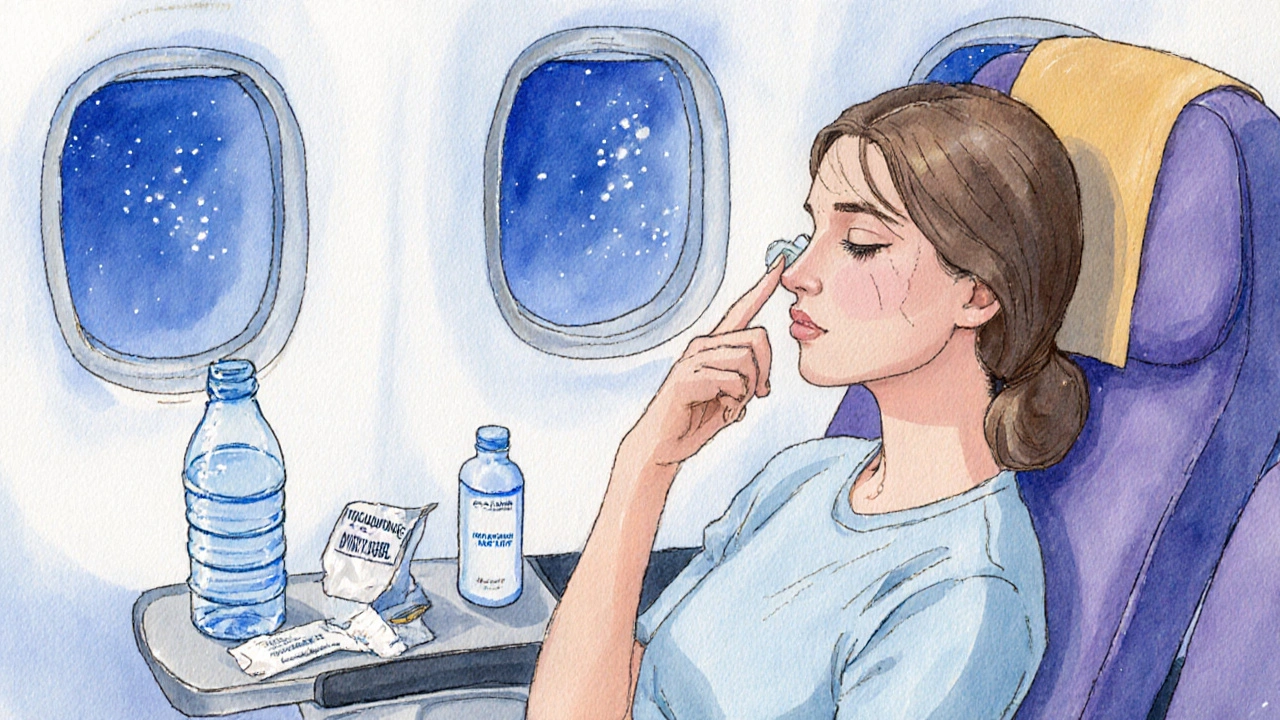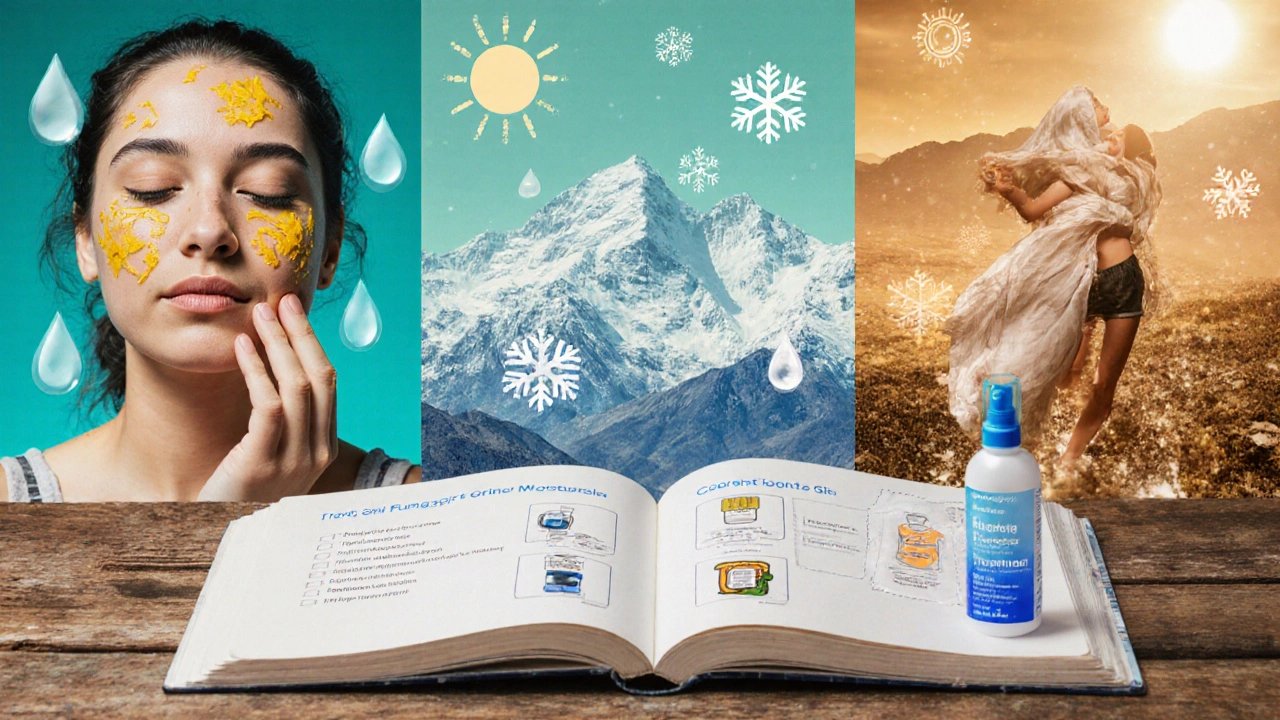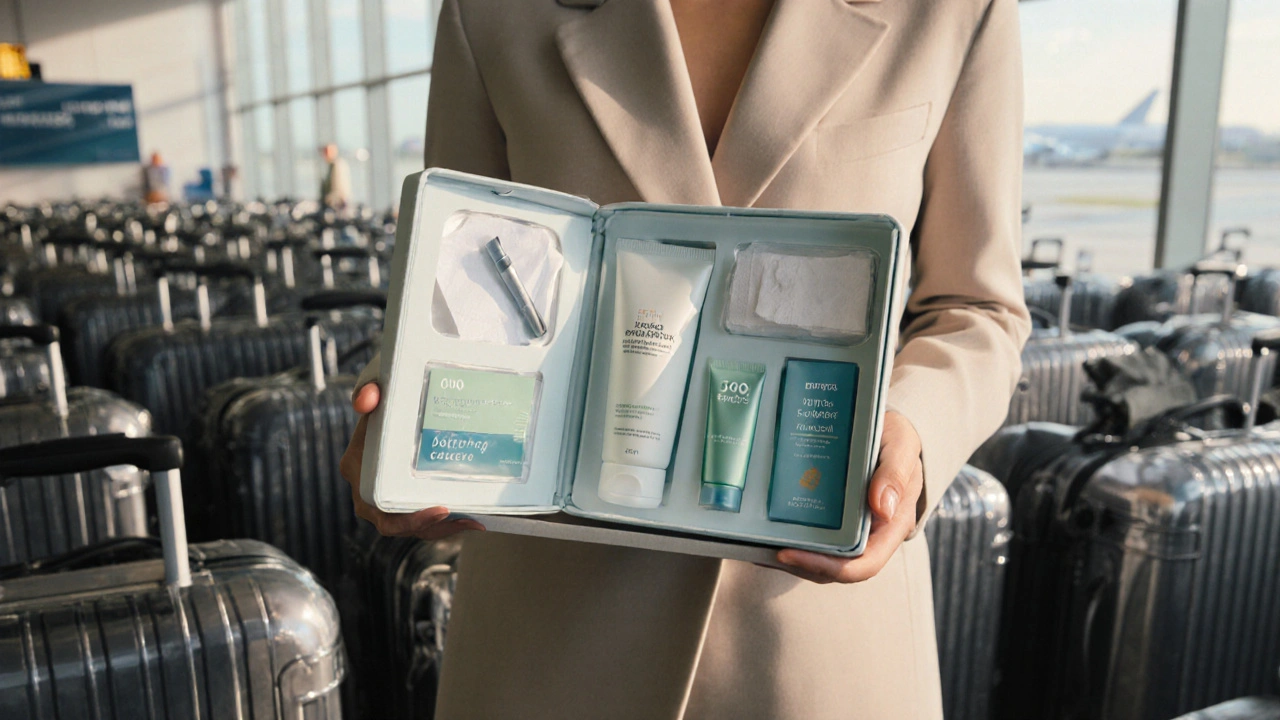Acne Travel Kit Planner
Your Travel Skincare Plan
Enter your travel details and click "Generate My Travel Skincare Plan" to see personalized recommendations.
Jet‑setting doesn’t have to mean swapping clear skin for breakouts. With a little foresight and a few smart habits, you can keep your complexion smooth whether you’re hopping on a plane, trekking through humid jungles, or navigating desert heat.
Why Travel Often Triggers Acne
Acne is a common inflammatory skin condition that flares up when oil, bacteria, and dead skin cells block pores. When you travel, several factors converge to create a perfect storm for those pesky pimples:
- Stress is heightened by changing schedules, flight delays, and unfamiliar surroundings, which spurs cortisol production and can increase sebum output.
- Climate shifts-from dry airplane cabins to humid tropics-alter skin barrier function and may cause extra oil or dryness, both of which invite breakouts.
- Hygiene routines get disrupted. Public restrooms, shared pillows, and limited access to clean water make it harder to keep skin spotless.
- Diet changes, such as indulging in rich street food or sugary drinks, can raise insulin levels and promote inflammation.
Understanding these triggers is the first step toward an effective acne travel tips plan.
Pre‑Trip Skincare Planning
Before you zip up your suitcase, set a clear game plan:
- Audit your current skincare routine. Identify which products are essential and which are luxuries you can leave behind.
- Pick travel‑friendly formats: pump bottles, refillable tubes, or solid bars that meet airline liquid limits (100ml per container).
- Choose non‑comedogenic products. Anything labeled “oil‑free” or “won’t clog pores” reduces the risk of new spots forming.
- Make a printable checklist (see the table below) so nothing vital gets forgotten.
In‑Flight and Airport Hacks
Airplane cabins are notorious for low humidity, which can dry out the skin barrier and cause over‑production of oil. Counteract this with a few simple moves:
- Stay hydrated. Aim for at least 8oz of water every hour; avoid excess coffee or alcohol, which dehydrate you further.
- Use a travel‑size moisturizer that contains hyaluronic acid. It hydrates without feeling heavy.
- Keep a pack of blotting papers in your carry‑on. A quick press removes excess shine without disturbing makeup.
- Sanitize your hands before touching your face. Portable, alcohol‑free wipes are a good compromise for sensitive skin.

Destination Care: Climate, Water, and Food
Once you land, adapt to the local environment:
- Hot and humid: Opt for a lightweight sunscreen with a matte finish (SPF30‑50). Sweat can mix with oil and clog pores, so a sweat‑resistant formula helps.
- Cold or dry: Layer a richer moisturizer and consider a humidifier if you’re staying in a hotel with central heating.
- Hard water: Use micellar water or a gentle cleanser to remove mineral residue that can irritate skin.
- Food choices: Balance indulgent meals with plenty of fresh fruit and vegetables. VitaminC and antioxidants support skin repair.
Quick On‑The‑Go Fixes
Even with the best prep, a surprise breakout can happen. Here’s how to tame it fast:
- Apply a spot treatment containing benzoyl peroxide or salicylic acid directly on the blemish. Let it dry before covering.
- Use a cold compress (a chilled spoon or a gel eye mask) for 5‑10minutes to reduce redness.
- If you’re out late, a mineral powder can absorb excess oil without adding heavy ingredients.
Nighttime Routine While Traveling
Even on the road, your skin needs a cleanse and repair phase:
- Double‑cleanse if you’ve been sweating or wearing makeup: first a gentle micellar water, then a foaming cleanser that removes excess sebum.
- Follow with a serum that contains niacinamide or retinol (if you’re already accustomed to retinol, keep the concentration low to avoid irritation from changing climates).
- Seal in moisture with a night‑time moisturizer that includes ceramides.

Common Pitfalls and How to Sidestep Them
Travelers often repeat the same mistakes. Spot the red flags before they cost you a clear complexion:
| Mistake | Why It Hurts | Smart Switch |
|---|---|---|
| Skipping moisturizer in dry climates | Barriers break down, prompting excess oil production | Carry a lightweight, hydrating gel |
| Using heavy, fragrance‑laden products | Fragrance can irritate and clog pores | Choose fragrance‑free, non‑comedogenic formulas |
| Touching face with dirty hands | Transfers bacteria and oil | Sanitize hands regularly; keep a barrier cream |
| Neglecting sunscreen | UV exposure worsens inflammation | Apply broad‑spectrum SPF30+ every morning |
Travel‑Friendly Skincare Checklist
| Item | Size (ml) | Key Feature |
|---|---|---|
| Gentle Cleanser | 100 | Non‑comedogenic, sulfate‑free |
| Hydrating Moisturizer | 50 | Contains hyaluronic acid & ceramides |
| Matte Sunscreen | 30 | SPF30‑50, sweat‑resistant |
| Spot Treatment | 15 | 5% benzoyl peroxide or 2% salicylic acid |
| Blotting Papers | - | Oil‑absorbing, no residue |
| Travel‑size Hand Sanitizer | 30 | Alcohol‑free, skin‑friendly |
Next Steps: Your Personal Travel‑Skin Action Plan
Take a minute to jot down three specific actions you’ll implement on your next trip-whether it’s swapping your regular cleanser for a travel‑size version, setting a reminder to drink water every 90 minutes, or packing a pocket‑sized spot treatment. Small, consistent habits beat big, occasional overhauls.
Frequently Asked Questions
Can I wear makeup while travelling without worsening acne?
Yes, if you choose non‑comedogenic, oil‑free makeup and remove it gently before bed. Mineral foundations with a matte finish work well in humid climates, and a micellar cleanser will dissolve the product without harsh rubbing.
Is it okay to skip my nightly routine on long flights?
Ideally you shouldn’t. Even a quick cleanse followed by a light moisturizer helps maintain the skin barrier, prevents oil buildup, and reduces the chance of “flight acne.”
How does altitude affect my skin?
Higher altitudes mean lower humidity, which can dry out the outer skin layer. Dry skin compensates by producing more oil, potentially leading to clogged pores. Hydrating mist sprays and a barrier‑repair moisturizer are key fixes.
Should I bring my prescription acne medication overseas?
Absolutely. Keep it in its original packaging, carry a copy of the prescription, and store it in your carry‑on to avoid loss. Check the destination country’s regulations before you travel.
Do I need a separate sunscreen for acne‑prone skin?
Look for sunscreens labeled “non‑comedogenic” or “oil‑free.” Mineral (zinc oxide or titanium dioxide) formulas tend to be less irritating than chemical filters and add a matte finish that helps control shine.

Virat Mishra
October 5, 2025 AT 13:53This guide is way too extra and useless.
Daisy Aguirre
October 7, 2025 AT 07:33Thanks for sharing this, I totally get how travel can mess with our skin.
First, stay on top of hydration by drinking water regularly, the cabin air is cruel.
Carry a travel‑size hyaluronic‑acid moisturizer and apply it right after you wash your face.
A lightweight, matte sunscreen protects you from UV and keeps the shine down, especially in humid places.
If you’re heading to a dry mountain area, add a barrier‑repair cream with ceramides to stop that tight feeling.
Blotting papers are a lifesaver; just press-not rub-to grab excess oil without disturbing makeup.
When you’re in a hotel with hard water, a gentle micellar cleanser will wash away mineral residue that can irritate pores.
Don’t forget your spot treatment; a dab of benzoyl peroxide or salicylic acid on a new blemish can stop it in its tracks.
Sleep schedules matter too-try to get at least seven hours, because lack of sleep spikes cortisol and oil production.
Snack smart: balance that tasty street‑food adventure with fresh fruit to keep insulin levels steady.
If you’re a retinol fan, stick to a low concentration and use it at night, but give your skin a break if the climate feels harsh.
A quick cold compress-like a chilled spoon-can calm redness after a breakout before you head out.
Pack a mini spray mist; a few spritzes mid‑day restore moisture without feeling heavy.
Lastly, set a reminder on your phone to reapply sunscreen every two hours when you’re outdoors.
With these habits in place, you’ll be able to explore the world without sacrificing clear skin.
Natalie Kelly
October 9, 2025 AT 01:13Exactly, keep it simple – cleanse, moisturize, sunscreen. Add a spot treatment if needed and you’re good to go.
Tiffany Clarke
October 10, 2025 AT 18:53Travel stress makes my skin act up like a drama queen no joke.
Sandy Gold
October 12, 2025 AT 12:33While the article covers the basics, it glosses over the nuanced interplay between humidity levels and sebum regulation, which is a critical omission for seasoned travelers.
The recommendation to "carry a travel‑size moisturizer" assumes a one‑size‑fits‑all approach, ignoring that occlusive creams are indispensable in arid high‑altitude destinations.
Moreover, the suggestion to use blotting papers in hot climates fails to consider that many of these papers contain added fragrances that can irritate compromised skin barriers.
There’s also a lack of discussion around the impact of UV‑A versus UV‑B radiation on post‑inflammatory hyperpigmentation, a concern especially for darker skin tones.
Finally, the piece could benefit from a deeper dive into the microbiome shifts that occur during long flights and how probiotic‑infused skincare can mitigate those effects.
Frank Pennetti
October 14, 2025 AT 06:13Deploying a barrier‑repair cream with ceramides is a non‑negotiable protocol for high‑altitude exposure; empirical data supports its efficacy in restoring transepidermal water loss metrics.
Adam Baxter
October 15, 2025 AT 23:53Stay pumped, keep that skin routine tight and you’ll crush those breakouts.
Keri Henderson
October 17, 2025 AT 17:33Great points overall! Just remember to patch‑test any new product before the trip so you don’t end up with an unexpected reaction.
elvin casimir
October 19, 2025 AT 11:13I gotta say the guide misses the mark on the importance of pH‑balanced cleansers – using a harsh acid can strip the skin and cause rebound oil.
Also, the term "spot treatment" is vague; you need a specified concentration to be effective.
And seriously, “drink water” is such a basic tip it belongs in a baby‑care pamphlet.
Lastly, the checklist could be formatted better – a simple table would improve readability.
Steve Batancs
October 21, 2025 AT 04:53While I appreciate the constructive criticism, the original article does provide a solid foundation for travelers seeking to maintain skin health.
Future revisions could incorporate the detailed suggestions mentioned above.